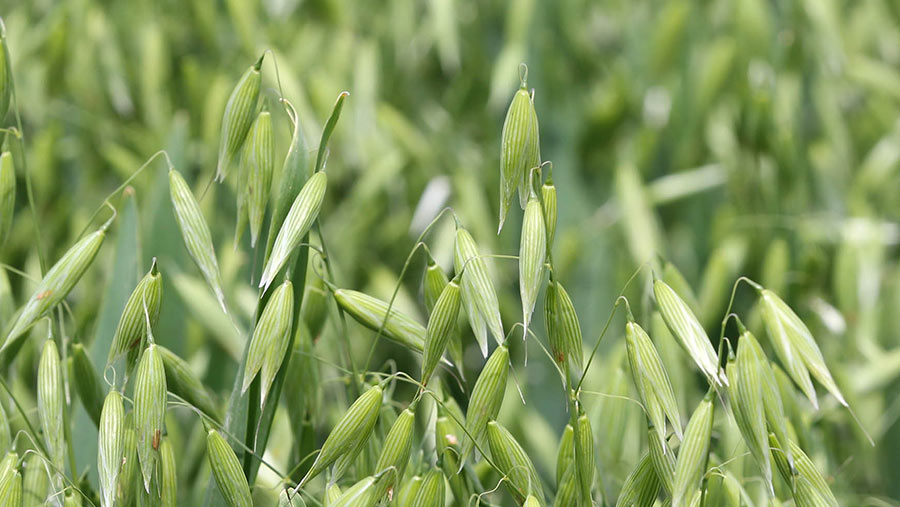Tips on growing a successful crop of naked oats
 © Tim Scrivener
© Tim Scrivener While naked oat crops require fewer inputs than other cereals, careful management including the robust use of growth regulators, is vital for maximising yields.
Some growers have been forced to plant spring crops, after the wet weather prevented winter wheat drilling this autumn.
The expected glut of spring barley has meant growers have been tempted to grow other specialist crops, such as naked oats with premiums of up to £45/t over feed wheat. However, getting it wrong could see growers missing out.
See also: 28 cereal and OSR varieties join AHDB Recommended List
Plant growth regulators
One key issue is lodging risk, as most naked oat varieties are taller than traditional husked cultivars.
In addition, oats begin rapid growth at the start of stem elongation (GS31) which increases chance of lodging.
The key is to deploy a robust growth regulation programme, in combination with the right fertiliser policy, to minimise risk.
Sky van Heyzen, naked oat manager at Agrii, explained how a Plant Growth Regulator (PGR) application during GS23-29 is normally required with a secondary application during GS31-32 necessary in some situations.
“There is no spring naked oat variety which stands perfect, so growth regulators are essential,” he warns.
Alatrin Evo (trinexapac-ethyl), Adjust (Chlormequat) and Canopy (mepiquat chloride and prohexadione calcium) are all recommend for use.
“It’s important to contact your agronomist regarding applications as naked oat cropping is very season dependant – sometimes one, two or even no PGR applications are required” says Mr van Heyzen.
Nitrogen
He recommended applying up to 140kg nitrogen/ha but this must be accounted for within the soil nitrogen supply index.
If the crop is sown in March, two 50% splits works well, with the first application applied during GS30-31 to avoid excess tillering and the remaining split in May to enhance grain weight.
During later drillings in April, N can be applied in one hit, provided the seed-bed is moist.
“The majority of nitrogen should be applied before stem extension, to minimise vegetative growth and green straw,” he adds.
Oats are also prone to copper and manganese deficiencies, so a broad spectrum soil analysis is advised before planting to see if nutritional seed dressings can provide benefits.
Drilling date and rate
Mr Van Heyzen advises an optimum sowing date of 15 March. However, the greater tolerance of oats compared with other spring cereals, allows for the sowing under difficult soil conditions, from February until late April.
“When planting early, creating a fine tilth and consolidating the seed-bed is essential whilst remembering frost risks. When planting later in the season, crops can become drought prone,” he says.
Seed rates can start from 320 seeds/sq m, but generally a rate of 375 seeds/sq m is used.
On heavy cold, clays seed rates in excess of 400 seeds/sq m are viable.
“Think about soil temperature and conditions before drilling, as this is paramount to decisions.”
Disease control
While oats have strong natural resistance to diseases, powdery mildew and crown rust are what growers should look out for.
“If there’s no disease, growers often don’t apply a fungicide, but this must be balanced with the season as yield benefits can be seen from fungicide applications, even when symptoms aren’t present,” explains Mr van Heyzen.
To avoid risk from soil-borne diseases such as oat mosaic virus and stem eelworm, oats should not be grown more than every four years.
“We have seen successful crops when growing oats, year on year, but it’s good practice to only grow them one in four,” he adds.
Harvesting and storage
Harvesting should take place when the majority of the grain separates from the hulls and the crop is fully ripe, to minimise hull retention.
Naked oats are covered in small hairs, which must be removed during harvest. Optimum combine settings are key to avoid grain loss during this process.
Storage is similar to OSR due to naked oats’ higher oil content than other cereals, but can be stored safely for long periods, at a maximum of 14% moisture.
Advantages of growing naked oats
Naked oats are prized for their nutritious, high energy grains used in the growing animal nutrition and health food markets.
The true cereal break-crop helps with blackgrass management by providing a long stale seed-bed.
Sky van Heyzen, naked oat manager at Agrii explains how their fibrous rooting system can potentially leave an improved soil structure for the following crop.
“Oats fill the ground and are great Scavengers. They are strong rooters compared with other cereals as they grow well through compaction zones.”

